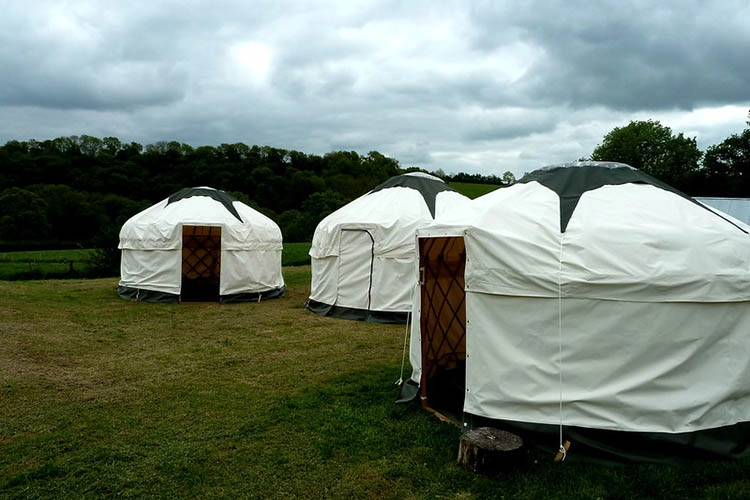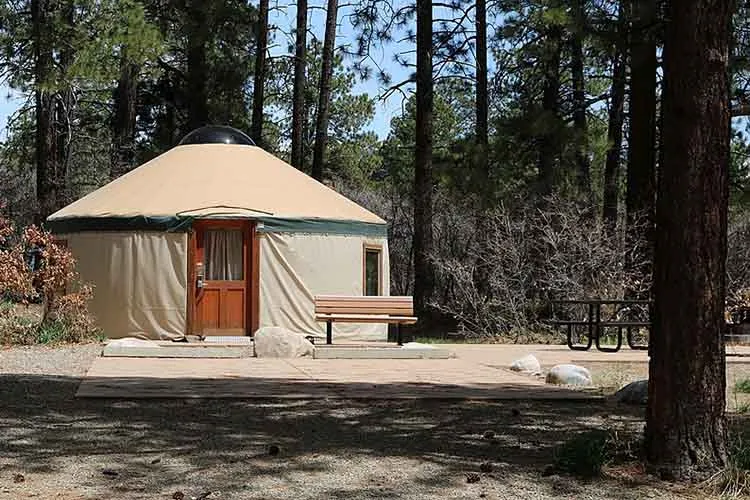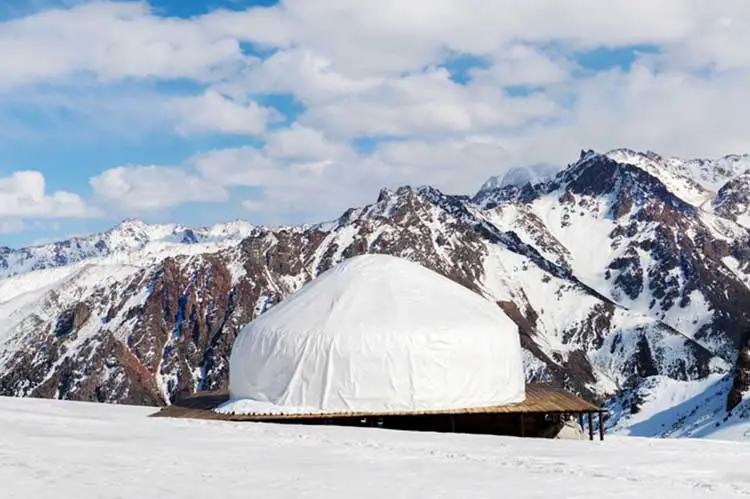Yurts are surprisingly strong buildings even though they are made with basic materials. Traditional yurts, like those found in Mongolia, are made with animal skins or felt, whereas modern yurts use high-end fabric such as DuroLast ® Polyurethane Fabric. The roof is the part of the yurt that is the most susceptible to decay since it is directly exposed to the elements. The roof will eventually deteriorate due to moisture and especially UV damage.
A yurt can easily last more than 20 years if properly cared for. Many modern yurt manufacturers offer a 15-year warranty on the roof. The interior wooden structure of the yurt, if made with rot and insect-resistant wood, should last decades. By replacing the roof cover and fabric walls, a yurt could last much longer.
Personal Experience: Our 16-year-old yurt is still in very good shape with only signs of minor deterioration around the edges of the roof cover fabric – this yurt is in Northern Minnesota and exposed to extreme temps and snow in the winter. We do prop up the rafters during the winter with extra supports to prevent damage from the snow load, and we wash the outside fabric once a year with a soft brush and warm soapy water.
Here are some of the top yurt manufacturers in the US and the corresponding warranty they offer on their roofs. As you can see, 10-15 years is typical. Even if you had to replace the roof at some point, the basic structure (floor, lattice walls and rafters) should last much longer. The rafters inside our yurt are made of kiln-dried Douglas Fir, which should last decades since it is not exposed to the elements.
| Yurt Manufacturer | Roof Cover Warranty |
| Blue Ridge Yurts | 8 Years |
| Pacific Yurts | 10 Years |
| Yurtz By Design | 10 Years |
| Yurts of Hawaii | 10/15 Years (Standard/Duro-Last roof) |
| Two Girls Farm & Yurts | 15 Years (Duro-Last roof) |
| Rainier Yurts | 15 Years (Duro-Last) |
Prolonging the Lifespan of Your Yurt
Here are some basic criteria that affect the lifespan of a yurt
Quality of Materials
The quality of the materials you use to build your yurt (or the kit you choose to purchase) will have the biggest impact on the lifespan of your yurt. While traditional yurts used natural fibers (felt, wool, or animal skins), most modern yurts use vinyl/polyester fabric. Some manufacturers offer higher-end fabrics, and some offer upgrades to a premium material such as DuroLast ® Polyurethane Fabric. These often add five years to the warranty. The type of wood used for the rafters, floor, and lattice walls has a major impact on the longevity of a yurt. Rot and insect-resistant woods are best, such as oak or douglas fir, for example. Treating the wood with a sealant will also increase its lifespan.
Proper Maintenance & Cleaning
Yurts do not require much maintenance compared to other types of dwellings. However, doing basic maintenance on a regular basis will increase the lifespan of your yurt. Check the integrity of the wooden rafters and walls on an annual basis, and check for cracks, moisture damage, and insect damage.
Cleaning the outside of your yurt at least once a year will help to increase the longevity of the fabric. Remove all sticks, twigs and leaves from the roof, especially from the folds of the fabric that tend to accumulate around window and door openings. One of the biggest problems in northern climates is the growth of moss or lichen on the outside of the roof and walls. Wash the outside of the yurt with a soft bristle brush and warm soapy water. You may need to scrub quite a bit to get off stubborn stots, but it’s much better than using a pressure washer that can damage the fabric.
Location and Weather Conditions:
The location where the yurt is set up can also directly affect its lifespan. Consider the climate when erecting your yurt. If you’re in a hot, dry location like a desert, UV rays can damage the fabric over the years. So yurt set up in direct sunlight in a very hot climate is likely to last less than one set up in partial shade in a northern climate. To extend the life of your exterior, you should try to locate the yurt with some shade to reduce sun exposure. A UV protector can also be applied to the fabric to reduce sun damage. It’s possible to extend the life of the fabric by shading it in hot temperatures.
Yurts set up in areas with high humidity are more prone to mold or mildew that can damage the structure over time. If your yurt is in a very damp spot, pay closer attention to mold and mildew and clean the outside more frequently.
In a wintery climate, you’ll want to ensure that the yurt can withstand the average snow load and winds. Remove snow more frequently and add additional supports under the rafters to avoid damage from snow loads. Covering your front door with an awning is a good idea if the weather is a factor.
Some of these issues may be inevitable since you cannot control the weather in your area or may not have many options on your land where to locate the yurt. However, choosing a spot that is less affected by high wind, constant sun exposure or very damp and stagnant areas (a spot that gets very little breeze or sun) can have a negative impact. If you can, pick a more neutral spot on your land with less exposure to extremes.
Use of the Yurt:
The lifespan of your yurt will also be affected by how it is used and who is using it. For example, is it being lived in year-round by one couple that cares for it as their home and maintains it with care, or is it being used as a short-term vacation rental where a different group is checking in every week? A seasonal guest house or lived in permanently? All of these things will likely affect the wear and tear on the yurt and potentially shorten the lifespan of your yurt so you may need to adjust your expectations.
Door and Frame
You can re-coat the external wood with a solid body or transparent cedar stain once a year or every two years. Before you apply the coat, sand the door and the frame. Use a lubricant with Teflon or graphite to keep the doorknob lubricated.
Dome Skylight
The dome skylight is a signature feature of the yurt. While they don’t last forever and may need to be replaced in about 15 years, you can also maintain them. Use hand-washing liquid and lukewarm water to wash the dome. Avoid cleaning sprays or chemicals. To avoid scratching the surface, use a soft cloth, not paper towels. Use clean water for rinsing.
Yurt living is increasingly popular as a living solution providing a viable alternative to the high cost of a home. They are a relatively affordable way to live and bring you closer to nature and the simple lifestyle many seek.
While yurts might conjure up images of hippy culture and nomads living off the grid, today’s yurt culture is sophisticated and can be as simple or luxurious as your budget allows.
They are also trending as vacation homes either for personal use or rental income. A boom in glamping resorts and yurts for vacation homes is a trend that continues to grow with sites like hipcamp and Airbnb offering yurts to rent for weekend escapes and outdoor adventures.
Yurts can serve a variety of other uses in addition to full-time homes. They are a great way to add extra space on your property for guests or in-laws, create a glamping experience for rental income, or be used for a home office, yoga or artists studio, fitness, or meditation space.
Yurts are used commercially as well – for growing businesses and for outdoor recreation such as ski huts, camping, summer camps, spas, and warming huts.
If you are thinking about building or buying a yurt for any reason, you might consider these companies that manufacture yurt kits, or if you’re handy, you can build one yourself.
View this post on Instagram
There are many benefits to yurt living:-
Building without Breaking Your Bank
In contrast to the high cost of a home or vacation home, a yurt can be built at a fraction of the price. The average price for a yurt is $10,000-$40,000. Of course, factors like the yurt’s size, the materials, the location, labor, and the amenities affect the final price. The cost of land and clearing the land is another factor.
Environmentally Conscious
Yurts use fewer building materials and leave a smaller footprint, making them an eco-conscious way to live. They tend to be smaller than the average home and some remain off the grid. However, modern conveniences like electricity and plumbing are becoming more common. The entire structure is relatively easy to build and can be moved with little impact on the surrounding environment.
Simple Minimalist Design
The ancient nomads or people of Mongolia made yurts for survival. Called ger in their language, the round temporal homes were ideal for the nomadic lifestyle as they were relatively easy to move. The simple circular design provided an open plan concept that is still beloved today. But while the design remains simple, modern yurts have evolved to include interior walls, electricity, bathrooms, stylish doors and windows, insulation, and more.
Close To Nature
Yurts are popular with outdoor enthusiasts for a good reason. Yurts are built for outdoor adventure, bringing you closer to nature and full-time outdoor living. Living in a yurt goes hand in hand with outdoor living with outdoor showers, dining al fresco, and sitting on the deck to stargaze.
If you are sold on the idea of living in a yurt, you might wonder how durable they are and how long they will last. A common misconception about yurts is that they don’t last very long or can’t withstand the elements.
View this post on Instagram
How Durable Are Yurts?
While the construction or a yurt is fairly simple and tent-like, they are actually quite durable. Most yurts are made using high-quality materials that are built to withstand the elements like sun, wind, snow, and rain.
The frame of the yurt can last invariably if you use quality wood, much like any other wood structure. Many yurt companies use chestnut wood for the frame, which is durable and can last as long as any other wood structure.
Douglas fir is another preferred wood that’s hard and stable and can withstand heavy loads. It fares well against strong winds and storms.
The durability of the fabric of the yurt depends on the elements. The average life span for the exterior is 10-12 years. Some manufacturers provide 15-year warranties with premium fabrics. Some quality fabrics have been known to last 20 years.
Most manufacturers ensure that yurts can withstand wind resistance between 95 and 105 mph. Additional support between rafters can also be used to help withstand snow load and to provide additional stability against the weather.
Some yurts use wood siding instead of fabric which can last longer and provide additional security against the elements.
Yurts can last for a long time, but various factors will affect their average life span. There are also plenty of tips to maintain your yurt for longevity.

Conclusion
With the right maintenance and care, yurts can be very durable and last a long time. The life span will depend on the quality of building materials, where the yurt is located, and how well you maintain the structure. If well cared for, a yurt can last far longer and provide many years of a fun outdoor lifestyle.


